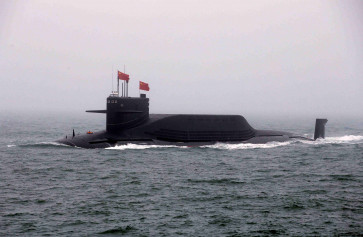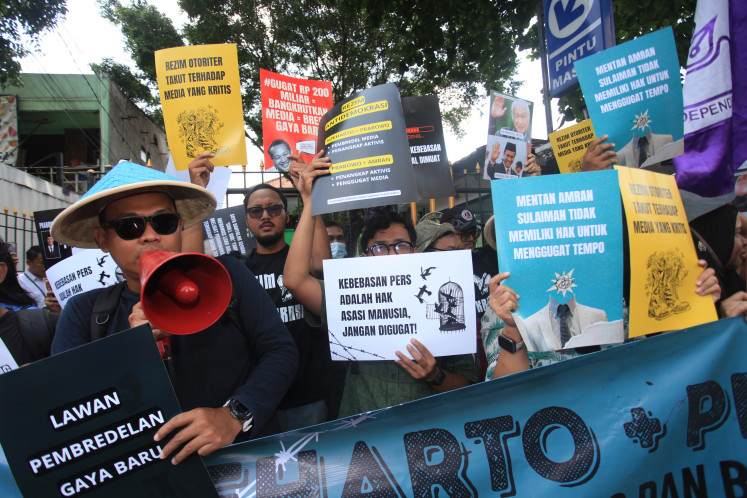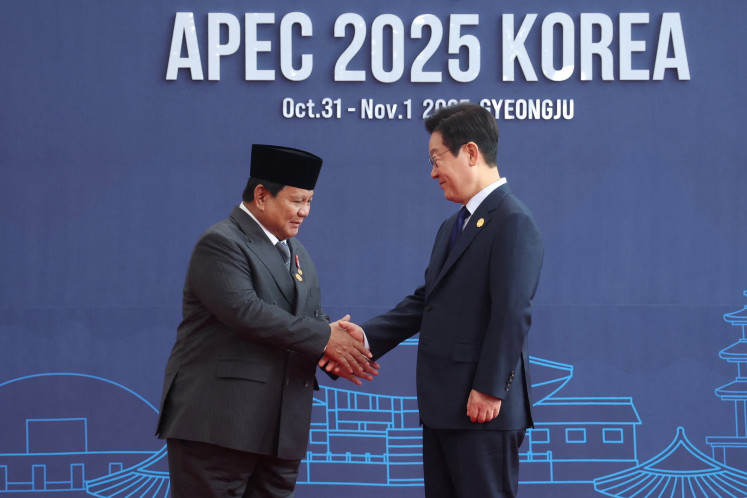Popular Reads
Top Results
Can't find what you're looking for?
View all search resultsPopular Reads
Top Results
Can't find what you're looking for?
View all search resultsFlagship species for conservation: Mantas, leatherbacks
In West Papua’s Kepala Burung (Bird’s Head) seascape, conservationists are working with local scientists to protect some of the world’s most endangered marine species
Change text size
Gift Premium Articles
to Anyone
I
n West Papua’s Kepala Burung (Bird’s Head) seascape, conservationists are working with local scientists to protect some of the world’s most endangered marine species. Marine Megafauna Foundation (MMF) and University of Papua (UNIPA) have started a collaborative research program on two “flagship” species of marine megafauna — manta rays and leatherback turtles.
Bird’s Head is in the heart of the coral triangle — the global epicenter of marine biodiversity. But this region, like the rest of Indonesia is highly threatened by human activities.
Recently highlighted at the Indonesian Shark and Ray Symposium on March 28 to 29, manta rays (plankton filter feeders) and leatherbacks (feed on jellyfish), are suffering from extreme level of marine pollution problems in Indonesia and the rest of Asia (both plastic pollution and chemical pollution from industry and agriculture) — which also pose a health risk to humans who eat contaminated fish.
Overfishing is another huge problem in the region. Despite a ban on killing manta rays in Indonesia since 2014, fishermen are still being encouraged to hunt them by illegal traders operating from
the large ports in China, Hong Kong, Vietnam and other Asian countries.
Their parts are sold in markets as a fake remedy for a variety of diseases, but this has no support from medical scientists. Leatherback turtles are even more threatened, classified as “critically endangered”, with only a few nesting beaches remaining globally.
There is an urgent need to protect both species in Indonesia to stop them disappearing forever. Protecting these “flagship species” will also allow protection of the pristine, biodiverse habitats that they live in.
Earth’s biodiversity is in crisis, with the current rate of species extinction 1,000 to 10,000 times higher than the natural background rate.
____________________________
One solution may be ecotourism, which can drive sustainable development.
Humans are removing up to 2.7 trillion fish from the oceans every year (Mood & Brooke, 2010), causing widespread population depletions, with scientists now saying that we are facing “unprecedented mass extinction” (Ceballos et al., 2015).
Species such are river dolphins and sawfishes may already be extinct and manta rays, leatherbacks and sharks will follow soon if governments and people do not take immediate action.
Some actions that should be taken include: stopping unsustainable overfishing (particularly of threatened species like sharks — often caught only for their valuable fins), providing alternative employment opportunities to fishermen (such as working in eco-tourism), preventing unsustainable development in coastal areas, reducing plastic production and use, stopping industrial and agricultural pollutants from entering the oceans via rivers, supporting the current global drive towards renewable energy sources, and educating young people to protect the environment.
One solution may be eco-tourism, which can drive sustainable development, provide alternative employment and help create marine protected areas to prevent overfishing.
The scuba diving industry in Indonesia is growing year by year and has potential to be a positive force for conservation if managed correctly. There is huge potential to grow the eco-tourism industry in West Papua, but care must be taken that development is sustainable (not uncontrolled mass tourism).
And there is a need to reduce and clean up plastic and other pollution in places like Manokwari to make them more attractive to tourists and help the local economy.
Also urgently needed is public pressure on government to provide funding to solve some of the big environmental issues. Asia has been identified as the area with the biggest pollution problems, but also where we can win the most from changes in government policy and education (The Economist, 2018).
Countries such as France and Bangladesh have now banned plastic bags, and others have committed large amounts of money to improve recycling and reduce chemical pollution from industry. Indonesia should follow their lead and make strong financial commitments to clean up the country’s oceans, and restore the people’s pride in their environment.
The research in West Papua can help draw attention to some of these issues. The pride and love that Indonesian people have for charismatic species like manta rays and leatherback turtles can be used as a significant force to generate public support to save them and the places where they live in.
The study will also allow Indonesian university students to gain valuable experience in field research and conservation. Divers and the public can also contribute to monitoring of these endangered species by reporting their presence on online platforms.
________________________
Robert Perryman and Ricardo F. Tapilatu are respectively researchers of Marine Megafauna Foundation at Macquarie University, Sydney and Research Center for Pacific Marine Resources at University of Papua, Manokwari.










